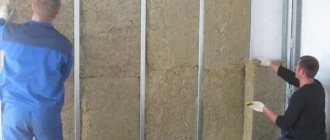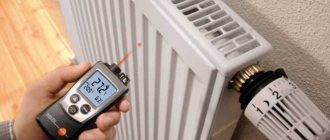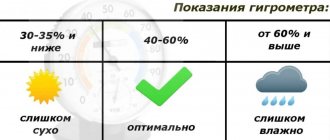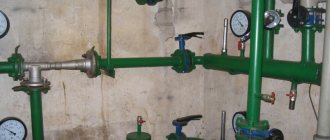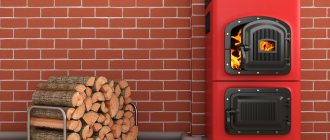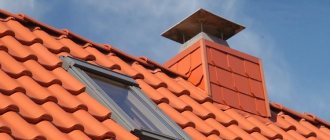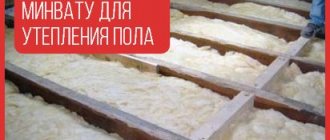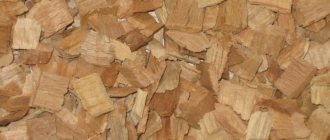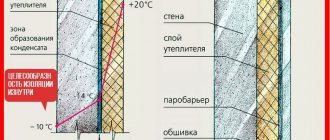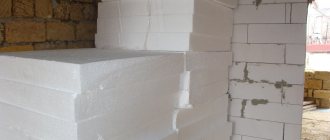Despite the fact that natural-based insulation materials are widespread, they also have negative sides. It seems like I have insulated the balcony, floors, walls, etc., but there is still not enough heat. The reasons lie not only in incorrect installation technology, but also in the thickness of the insulation and how correctly it was chosen. Since the thickness of the material affects the thermal properties of the thermal insulation system, it should be selected taking into account the climate of the place of residence and the technical data of the surface to be insulated. It is impossible to choose a universal insulation to optimally solve the problem. While you are experimenting, you will end up with financial overruns or the created thermal protection will not be able to store heat.
Advantages and disadvantages of ceiling insulation with mineral wool
This option is used in almost all buildings, providing a comfortable atmosphere in the premises. The ceiling can be insulated from the outside and inside. The cost of these works is almost the same. The quality of the result depends on the qualifications of the craftsman and the insulating material. You can do this work yourself, relying on the advice of professionals that can be found on the Internet. Many people insulate their home with mineral wool, since this material has almost no disadvantages and many advantages compared to other insulation materials. These include:
- affordable price;
- ease of use;
- the appearance of pests and various insects and rodents in the fabric is excluded;
- no toxicity;
- fire resistance;
- moisture resistance;
- rotting is not typical;
- protection against mold and other microorganisms;
- good noise insulation and heat insulation qualities;
- environmental friendliness, the material is not harmful to human health;
- vapor permeability, allowing the ceiling to “breathe” (keeps the room cool in summer, keeps warm in winter);
- resistance to mechanical manipulation.
There are also disadvantages, but they are not significant and do not in any way affect the quality of insulation. The main one is the reduction in thermal insulation data when compacting material in the packaging workshop. It can also lose its qualities when wet. Therefore, it must be protected from wet weather.
How to insulate a ceiling with foam plastic
Quite often, foam plastic is used to insulate the ceiling in a house with a cold roof. Its popularity is based on its ease of installation. Polystyrene foam is lightweight, so it can be used even in houses with light floor construction.
Polystyrene foam does not absorb moisture, so vapor barrier is not required. You can use the material in slabs or in bulk. Foam insulation is carried out both from the inside of the house and from the outside.
It is important to keep in mind that if the roof is gable, then it is better to insulate the ceiling from the inside.
Installation of foam plastic from the outside should begin with waterproofing the floors. Next, you need to cut the material so that it fits easily between the beams, and foam the remaining cracks.
It is necessary to lay glassine on top of it. If the roof of a private house is very cold, especially in winter, then it makes sense to put a layer of mineral wool on the foam.
Between the thermal insulation material and the waterproofing layer it is necessary to leave a small space for ventilation. If this is not done, moisture may appear inside the room.
What should be the thickness of the insulation for the ceiling?
Some of the people who have insulated their ceilings with mineral wool complain about its quality: the appearance of excess moisture, drafts, and heat leaving the house. In fact, the reason is not the quality of the insulation, but a violation of the technological process during installation or its insufficient thickness. If the roof of the house is not insulated, and the ceiling belongs to the top floor of the building, then internal insulation alone will not be enough to maintain a normal microclimate in the room. The thickness of mineral wool depends on the specific structure. Here you need to take into account more than one factor in order to properly insulate the ceiling. The standard thickness of mineral wool for a house with an unheated attic is 10-16 cm. If the roof is not insulated, the insulation layer is doubled. But you can insulate the ceiling from two sides at once: internal and external. If a decision is made to insulate a pitched roof, the thickness of the insulation should be 15-30 cm. An important thermal insulation indicator is the quality of installation, and not just the installation itself.
Choosing the optimal insulation
First of all, you should figure out what is the best way to insulate the ceiling of a private house, which is mounted on floor beams. Homeowners use various natural and artificial materials for these purposes. The most common of them include:
For ceilings on joists, the most optimal insulation option is basalt wool
- polyurethane foam;
- expanded clay;
- perlite;
- Styrofoam;
- sawdust;
- straw.
Professional heating engineers recommend using basalt wool as insulation for the ceiling in a private house. This is the optimal choice for thermal insulation of ceilings along joists.
Thanks to mineral wool, you can improve sound insulation and keep your home warm
Basalt wool has a number of undeniable advantages:
- long service life;
- biological neutrality;
- high fire safety;
- high vapor permeability;
- increased sound insulation;
- low hygroscopicity;
- ease of installation;
- low thermal conductivity;
- ease.
Basalt wool does not change its technical characteristics for decades, which will not require replacement of insulation throughout the entire life of the building. In addition, cotton wool does not shrink and does not reduce its performance after many years.
Basalt wool is not susceptible to fungus, mold and rotting
Excellent soundproofing characteristics will allow the inhabitants of the upper and lower floors of the house not to disturb each other with excessive noise. Possible contact of liquid with the material will not affect its performance in any way. All work with this type of insulation is done manually and does not require the owner of the house to have special equipment.
Low thermal conductivity makes it possible to use insulating mats with a thickness of no more than 10 cm, which is ideal for thermal insulation of the ceiling in a private house. Due to its porous structure, wool is lightweight - this facilitates installation work and does not create unnecessary load on the base of the building.
The only disadvantage of basalt wool is its rather high cost. However, before you insulate the ceiling in a private house outside and inside, you should think not only about the initial costs, but also about the durability of the ceiling. Cheap thermal insulation material will not provide adequate comfort and will cause many problems during the further operation of the building. Good insulation for the ceiling of a house must meet modern standards and meet all fire safety requirements.
You can insulate the ceiling with your own hands, you can see this in this video:
Price
Whether the ceiling needs to be insulated or not depends on the climate of the region where your house is located. During construction, the projects already include an article on insulation, since this is an unprincipled measure of energy-saving policy in our lives. Due to its low price and high heat-saving qualities, mineral wool is often used for insulation in everyday life without the help of hired craftsmen. The average price of a roll with standard parameters (10 × 1.2 m, thickness 5-20 cm) is 1200 rubles, and the price of 1 m² will cost 100 rubles. The cost of the work performed to insulate 1 m² will be approximately 70 rubles. Based on this, you can easily calculate: insulating a ceiling with an area of 20 m² will cost 4,800 rubles. (1200 RUR ×2 + 120 RUR ×20 m²).
Selection of thermal insulation material
In order to effectively insulate the ceiling of a private house using mineral wool, you need to choose it correctly.
Professionals base their choice on the material’s compliance with a number of characteristics. According to form
- The mats have low strength characteristics. They are produced in the form of rolls, which increases the convenience of their transportation.
- The slabs have a higher level of strength. They are divided into semi-rigid and rigid.
- Cylinders are a specialized material used for thermal insulation of pipelines.
https://www.youtube.com/watch?v=tb2D1CNom_I
By type of primary raw materials used for production:
- basalt wool
- glass wool;
- slag.
Expert opinion
Konstantin Alexandrovich
The most common type is basalt wool. Other names for the material are stone wool or quartz mineral wool. It is distinguished by a high level of strength. Insulation is successfully used to insulate walls and ceilings that experience significant loads, including mechanical ones. The raw material for the production of this type of insulator is fragmented basalt subjected to a melting procedure. The structure of the material contains many fibers. Final processing includes pressing and prolonged high-temperature heating. One of the forms of basalt wool production is slabs.
The advantages of mineral wool include durability and ease of installation.
Mineral wool is considered the most environmentally friendly thermal insulator. It differs from polystyrene foam in that it does not emit harmful substances even when heated. In addition to this, it has other advantages:
- does not rot;
- vapor permeable;
- not afraid of mechanical loads;
- not susceptible to damage by rodents and insects;
- holds heat well;
- has soundproofing properties;
- easy to install;
- durable;
- is relatively inexpensive.
An important advantage is that cotton wool is fireproof, it does not support combustion and does not create smoke.
First of all, I want to talk about insulation methods. Obviously there are two of them:
- internal - in this case, the heat-insulating material is installed inside the living space, that is, it is fixed to the ceiling surface;
- external - we are talking about installing insulation on the surface of the attic floor from the side of the roof space.
You can insulate the ceiling from the living room side...
The first method, in my personal opinion, has several important disadvantages:
- When installing insulation, the distance between the ceiling and the floor is reduced, which negatively affects the appearance of the room and the ease of its use;
- To install insulation in a room, you will have to dismantle the decorative finishing of the ceiling, and then install the facing materials again.
- The insulation process itself will be somewhat difficult, since you will have to use various devices such as stepladders or scaffolding, and you will also be in an awkward position, working close to the ceiling.
- If only the ceiling (and not the roof slopes) is subject to insulation, then the thermal inertia of the ceiling and its service life are reduced. The ceiling material will be subject to cyclic freezing and thawing, as a result of which the internal structure of the wood is gradually destroyed and it becomes unusable.
... and the attic.
Therefore, I resort to internal thermal insulation only in those rare cases when it is impossible to do this from the outside for objective reasons. Moreover, if you insulate the ceiling in a wooden house from the attic side, you can get many important advantages:
- The internal dimensions of the residential premises remain unchanged. Regardless of the thickness of the insulation cake, all of its layers will be in the attic and will not reduce the distance between the ceiling and floor, making the room too low.
- Wooden ceiling parts, in addition to serving as additional thermal insulation, accumulate heat coming from the living space and then gradually release it back. That is, if the outside air temperature drops for a short time, there will be no need to turn on the heating devices.
- During external insulation, waterproof films are installed that protect wooden floor parts from destructive external factors. In particular, moisture. This extends the life of the building's structural elements.
- Carrying out external insulation work does not in any way affect the decorative finishing of the ceiling on the side of the living room. Therefore, you do not have to incur additional finishing costs, and work can be carried out at any time (even after the construction of a residential building is completed).
The exterior design of a wooden house with a ceiling made of wooden beams lined with boards or plywood is especially good. In this case, there is no need to construct additional sheathing for laying the heat insulator. The entire process takes less time and requires less investment.
When insulating the ceiling in a wooden house, the role of joists is played by the supporting floor beams.
Therefore, further I will only talk about how to insulate the ceiling in a private house from the attic side.
Any craftsman who decides to take on insulation is faced with the question of choosing a thermal insulation material. The most common are polystyrene foam and mineral wool.
Foam or cotton wool: that is the question.
Considering that the first is a fire hazard, I categorically do not recommend using it for thermal insulation of wooden buildings. It is better to give preference to basalt fiber mats. Although the price of this insulation is slightly higher than construction polystyrene foam, it has several important advantages, which you will learn about from the table below.
| Peculiarity | Description |
| Low thermal conductivity | Mineral fiber insulation consists of microscopic basalt fibers glued together with air between them, which serves as an excellent heat insulator. Thanks to it, the thermal conductivity coefficient of basalt mats is about 0.038 W/(m*K). This means that for high-quality insulation of the ceiling of a house located in central Russia, it is enough to lay stone wool 10 cm thick. |
| High hygroscopicity | Basalt stone fibers do not absorb water. And mineral mats are made using phenol-formaldehyde resins, which contain water-repellent agents that prevent the accumulation of moisture inside the insulating layer. Therefore, water entering the layer of insulation laid in the attic floor does not linger there and does not reduce the thermal conductivity coefficient of the material. However, this does not mean that you can refuse to use hydro- and vapor barrier films. |
| High vapor permeability | Mineral wool insulation has an open internal structure, which allows it to be classified as a “breathable” building material. The thermal insulation layer does not prevent air infiltration through the enclosing structures, so a comfortable microclimate with an average level of humidity is formed inside residential premises. |
| Low fire hazard | Mineral wool is made from gabbro-basalt, so the insulation fibers melt only at a temperature of at least 1100 degrees Celsius and do not ignite. It follows from this that the insulation is not only fireproof, but also prevents the further spread of flame in a wooden building. In addition, when heated, the material does not emit chemical compounds hazardous to humans. |
| Environmental Safety | Basalt fiber itself does not pose a risk to human health. However, in the production of insulation, phenolic resin is used, which makes up about 2% of the volume of the material. To minimize its impact on others, mineral mats are heated, so the finished product has virtually zero emissions of substances harmful to health. |
| Easy to install | The insulation is cut according to the markings using a regular knife, and inexpensive brackets are used for fastening (if necessary). Even a novice craftsman can handle the technology of laying a thermal insulation layer, but he must observe several important nuances, which I will discuss below. |
Mineral wool is my choice.
If we talk about specific types of insulation, then I recommend using TechnoNIKOL Rocklight mineral mats with a thickness of 50 mm and dimensions of 120 by 60 cm, laying them between the supporting floor beams in two layers.
Step-by-step instructions for insulation
Covering the ceiling with mineral wool helps to retain heat longer and prevent the appearance of mold and fungal formations on it, which can appear due to condensation formed from the difference in temperatures inside and outside the room. Insulation is produced in rolls and slabs. When choosing, you need to pay attention that one of its sides is covered with foil, insulating the mineral wool from moisture. If this is not the case, you need to buy foil polyethylene foam or thick plastic film. Glassine can be used as a vapor barrier material. This entire additional kit is necessary for the mineral wool to retain its qualities for a long time. Among other things, you will need self-tapping screws, plastic fasteners with a wide head, a counter rail, a profile and hangers for it, special glue for mineral wool, a stationery knife, a mounting stapler, a screwdriver, a tape measure, a hammer and nails.
Insulation in a private house
The issue of insulation is relevant both for apartment residents and for those who live in a private house.
Insulation is the best way to eliminate problems of heat loss through the ceiling. By doing this simple procedure, you will provide warmth to the room during cold winter evenings.
The most common material used for insulation is mineral wool. Its advantages include the final price for ceiling insulation and the environmental friendliness of the material.
If you install insulating material incorrectly, you can lose up to 40% of its thermal insulation properties in a year. Loss will occur due to the material getting wet or sagging. Heat loss can be detected using a thermal imager.
Insulation from the inside
This procedure is typical for apartments and houses with an attic or several floors. The work is carried out in stages:
- The sheathing is made from boards with a cross-section of 30-40 × 100-200 mm, the width of which is determined by the thickness of the insulation or metal profile and then fixed to the ceiling with nails or self-tapping screws at a distance of 50-60 cm from each other.
- Next, a waterproofing layer is installed. To do this, cut strips 60-70 cm wide, including an allowance of 5 cm on each side, and attach them with counter-battens to the wooden sheathing or to the profile with self-tapping screws.
- Now you need to lay and secure the mineral wool with glue or a stapler.
- Vapor barrier. The glassine is attached to the mineral wool using a construction stapler.
- The entire structure is fixed across with brackets or a profile.
- Finishing work flow. Mounting on plasterboard, suspended ceilings, panels.
Penoizol as insulation
An alternative to polystyrene foam and polyurethane foam can be penoizol, which is a “liquid” foam. Thanks to special additives, it gets rid of the main disadvantages of its solid counterparts - attractiveness to rodents and flammability. The disadvantage of penoizol is that to apply it you need to call a team of workers with special equipment, and this can be quite expensive.
Ceiling insulation with foam insulation
The technology of insulation using penoizol is simple: we lay a vapor barrier and fill the space between the attic beams with a layer of insulation to a thickness of 20-30 centimeters. You can additionally lay a layer of roofing material on top and lay a plank floor.
The prefix “eco-” in the title of this material is not used for advertising purposes. Ecowool is truly an environmentally friendly material, as it consists of 80% natural cellulose. The remaining 20% are various additives, such as lingin, which gives the structure stickiness, or boric acid and antiseptics, which protect ecowool from rot, fungus and rodents. This material also contains fire retardants, thanks to which ecowool does not burn, but only smolders under the influence of flame and very high temperatures. Thermal conductivity of the material is 0.038 W/(mK).
Using ecowool to insulate ceilings
There are two ways to insulate the ceiling using environmentally friendly cotton wool - dry and wet. In the first case, the material is placed in prepared “cells” of the ceiling, but its thermal insulation properties will be only 60-70% of the possible ones. The second method uses special equipment that moistens ecowool and sprays it under high pressure. When in contact with water, the insulation becomes sticky and adheres tightly to the surface of the ceiling or attic. The disadvantage of ecowool is precisely that for its “wet” application you will need special equipment and people who know how to work with it.
Let's consider the stages of insulating the ceiling using ecowool externally.
The surface of the ceiling is cleaned and leveled - it is necessary to get rid of dirt and construction debris. A lathing made of wooden beams is installed, similar to the lathing for laying mineral wool. If desired, you can skip this step, but then it will be impossible to use the attic. A layer of vapor barrier film is laid. If necessary, you can wrap the sheathing structure itself in it. Using a blowing machine, ecowool fills the space between the slats
Particular attention should be paid to cracks and hard-to-reach places. The minimum layer of insulation should be 25 centimeters, but if you live in an area with very cold winters, then the thickness should be increased to 40-50 cm. A waterproofing film is laid over the ecowool, overlapping and with the seams secured using special tape.
External ceiling insulation with ecowool
External insulation
This option is suitable for private buildings with an attic. Compared to the previous one, it is much simpler to implement and is also carried out in stages:
- Cover the area in the attic with a layer of glassine overlapping 50-10 cm and glue the joints with tape.
- As in the previous case, fill the sheathing.
- Lay foam plastic 5 cm thick on the vapor barrier layer, due to which the degree of vapor barrier will increase significantly.
- The next layer is mineral wool 10-20 cm thick. It must be laid so that there are no gaps between the insulation layers and the sheathing strips.
- If the mineral wool is with foil, it is laid so that the foil side is on top. Then additional waterproofing is not needed. Otherwise, the top of the insulation is covered with an overlap of waterproofing material. The joints are sealed with tape, and everything is secured with counter-battens.
- The floor covering is being installed.
Mixed insulation is used in rooms where it is necessary to maintain elevated temperatures for a long time (baths, steam rooms, saunas, etc.).
Sawdust as insulation
Finally, we come to a material that has been used as insulation for decades, even before foam and mineral wool were invented. This is sawdust. They can be used either independently, simply filling the attic with them, or as part of a mixture with clay or cement.
The only advantage of such insulation is its low cost - you can either use waste from your own construction, or go to the nearest sawmill and get the material for free or for a nominal price. But does the cheapness of sawdust outweigh all its disadvantages?
- Sawdust burns well, so when using it, you should protect all electrical wiring in the attic with metal boxes. In addition, this material should not be used near a stove or fireplace chimney.
- Rodents, insects or fungus may appear in the sawdust, and without impregnation with an antiseptic it will not be possible to get rid of these problems.
- The material shrinks greatly over time, which significantly worsens its thermal insulation properties. In addition, you will have to regularly add fresh sawdust.
- With such insulation, it is impossible to use the space under the roof - neither build an attic, nor store old furniture and other things in the attic.
Ceiling insulation with sawdust
The cement-sawdust solution is prepared as follows: for 10 parts of sawdust of fine or medium fraction, take 1 part cement and 1 part lime. The substances are thoroughly mixed together until a dry mixture is formed. Then you need to take 5-10 parts of water mixed with a few tablespoons of copper sulfate. In our case, vitriol acts as an antiseptic that will prevent the sawdust insulation from rotting. Pour in the mixture and bring it to a homogeneous mass. Checking whether it is ready is quite simple: take the cement-sawdust mixture and squeeze it in your fist. If no water drips from it, then it is ready.
Using clay with sawdust for external ceiling insulation
Next, you need to prepare the attic for insulation. To do this, you need to lay a vapor barrier material and treat all wooden structural elements with a fire retardant (impregnation that protects against burning). After this, you need to lay out the cement-sawdust mixture, level it and leave it for a couple of weeks so that it dries completely.
Adviсe:
- Small fibers of the material, if they enter the respiratory tract or onto the skin, lead to itching and irritation. Therefore, you should use special clothing, goggles and a respirator.
- After attaching the profile, all corner areas must be thoroughly filled with construction foam so that cold does not penetrate through them.
- Due to errors in calculations, the thickness of the mineral wool may overlap the width of the sheathing. Then auxiliary blocks are nailed onto the boards of the latter. If a profile is used, you will have to change the hangers or reduce the thickness of the mineral wool.
- When laying cotton wool, you cannot compact it, because... in connection with this, the number of air bubbles decreases, and, accordingly, the level of quality of thermal insulation decreases.
- The places where spotlights will be installed must be provided with space sufficient for free air circulation to avoid their premature burnout.
- To install a metal profile, use self-tapping screws made of hardened steel with a frequent thread cut.
- You can check the condition of the mineral wool insulated duct using a thermal imager, which will indicate in red the areas where cold is passing through.
All of the above will help optimize costs, both material and physical, to perform all of the above work. To get better results, you can seek the help of specialists. They will help you correctly calculate the required thickness of insulation, based on which you can calculate the required quantity, as well as the cost. As a rule, these companies cooperate directly with mineral wool manufacturers, which makes it possible to further save on it when purchasing.
Brief characteristics of materials for insulation
Today, the most popular insulation materials used to insulate the ceiling in a wooden house are:
1. Ecowool, which is also called cellulose wool. An environmentally friendly and safe material for human health, consisting of long cellulose fibers obtained from recycling waste paper. The composition of this insulation contains substances that prevent combustion and biological effects. It has good heat and sound insulation characteristics. You can buy ecowool from the manufacturer in Moscow for 860-910 rubles per 1m3.
3. Mineral, or as it is also called, stone wool, is produced both from slag and other waste from metallurgical and other industries, and from glass and various rocks. Ceilings in wooden houses are insulated only with mineral and glass wool, and the popularity of the latter has decreased significantly these days. Mineral wool is fire-resistant, vapor-permeable, not susceptible to various aggressive chemical substances and biological damage by microorganisms; moreover, rodents, which like to nest in polystyrene foam, do not make nests in it and generally do not like it.
How to insulate with mineral wool?
If you have decided that you will insulate the ceilings in a private house with your own hands, then you need to buy mineral wool in slabs, since it is most convenient to work with them. In addition, you will need: a special waterproofing film or glassine, or other waterproofing materials; metal or wooden racks for the frame, drywall.
Warming stages:
Attaching a layer of waterproofing material, preferably glassine, to the ceiling surface using an adhesive
It is important that the edges of the insulation overlap each other with a minimum overlap of 5 cm. Assembling a frame made of wood or metal guides using dowel-nails and a hammer drill. Laying mineral wool slabs while simultaneously gluing them to tile adhesive. If there is a need and opportunity, then a second layer of this heat insulator is laid. We attach another layer of waterproofing on top of the mineral wool. We cover it with boards or plasterboard sheets.

